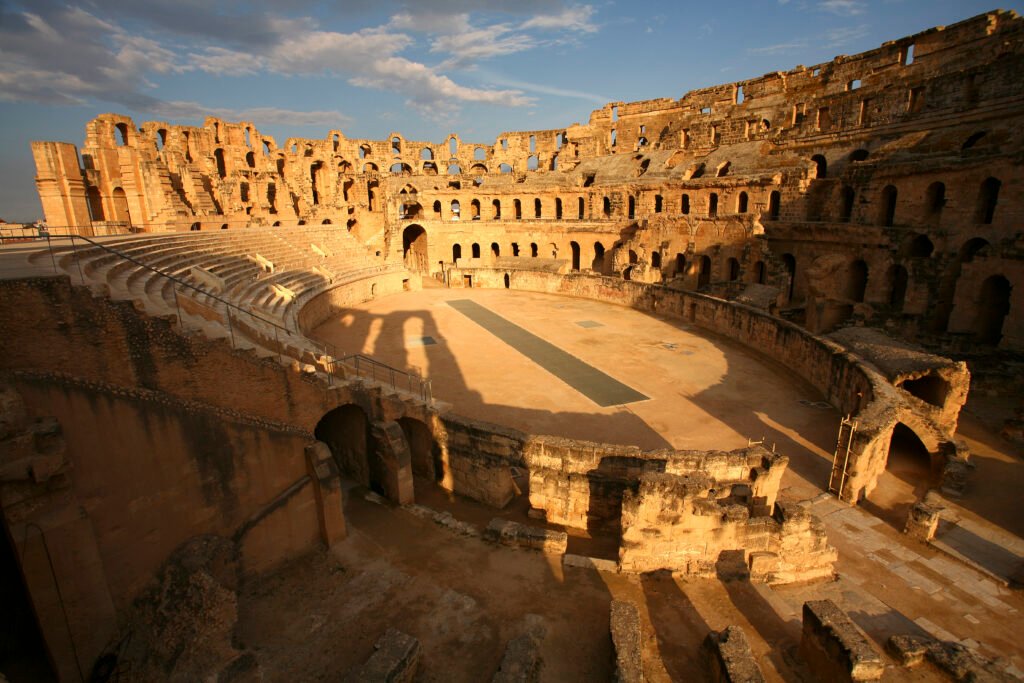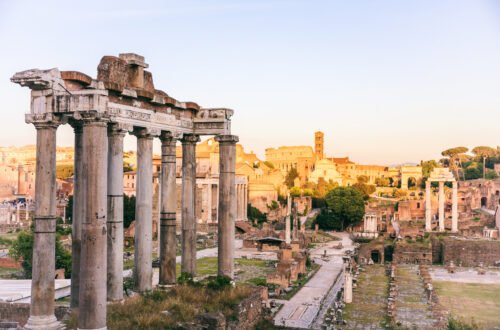Exploring El Djem Amphitheater: A Comprehensive Guide to the Ancient Marvel

The El Djem Amphitheater is one of the most impressive ancient structures in the world. It is a true marvel of architecture and engineering that has stood the test of time. Located in the town of El Djem in Tunisia, this impressive structure dates back to the 3rd century AD and was capable of seating up to 30,000 spectators. Today, the amphitheater is a UNESCO World Heritage Site and a popular tourist attraction for visitors to Tunisia. In this comprehensive guide, we will explore the history, architecture, and significance of the El Djem Amphitheater. We will delve into the details of its construction, the events that took place there, and the reasons why it has become such an iconic symbol of the ancient world. Whether you are a history buff or simply looking for an interesting place to visit, this guide will provide all the information you need to fully appreciate this amazing ancient marvel.
Introduction to El Djem Amphitheater
Located in the enchanting country of Tunisia, the El Djem Amphitheater stands as a remarkable testament to the grandeur and architectural prowess of the ancient Roman civilization. Often hailed as one of the most impressive Roman amphitheaters in the world, this majestic structure draws visitors from far and wide to marvel at its historical significance and stunning design.
Dating back to the 3rd century AD, the El Djem Amphitheater, also known as the Thysdrus Amphitheater, was constructed during the reign of the Roman Empire. Built to accommodate an astonishing 35,000 spectators, this colossal amphitheater was primarily used for gladiatorial contests, chariot races, and other public spectacles that captivated the crowds of the time.
What sets the El Djem Amphitheater apart from other ancient arenas is its incredibly well-preserved state. Despite facing centuries of wear and tear, this architectural wonder has managed to retain much of its original structure, allowing visitors to step back in time and experience the magnificence of ancient Roman entertainment.
As you approach the amphitheater, the sheer size and grandeur of the structure become apparent. Its massive elliptical shape, towering walls, and intricate network of arches showcase the engineering brilliance of the Romans. The imposing facade, adorned with intricately carved stone reliefs, transports visitors to a bygone era of gladiatorial battles and extravagant festivities.
Stepping inside the amphitheater, you can’t help but be awestruck by the sheer scale of the arena. The vast oval-shaped interior, surrounded by towering tiers of seating, once echoed with the cheers and roars of the enthusiastic crowds. Imagine the adrenaline-filled atmosphere as gladiators faced off against each other, showcasing their strength, skill, and bravery in the pursuit of glory.
Today, visitors can explore the multiple levels of the amphitheater, climbing the stairways that lead to the upper galleries. From these vantage points, you can admire the panoramic view of the arena, gaining a deeper appreciation for the architectural genius behind this ancient marvel.
Whether you are a history enthusiast, an architecture aficionado, or simply someone seeking to immerse yourself in the rich cultural heritage of Tunisia, a visit to the El Djem Amphitheater is an absolute must. Prepare to be captivated by the centuries-old stories that echo through its corridors and let the grandeur of this ancient wonder transport you back in time.
Historical background and significance of El Djem Amphitheater
The El Djem Amphitheater, also known as the Thysdrus Amphitheater, is a mesmerizing ancient marvel that stands as a testament to the grandeur of the Roman Empire. Located in the small town of El Djem in Tunisia, this remarkable amphitheater is one of the largest and best-preserved Roman amphitheaters in the world.
Built in the 3rd century AD, during the reign of Emperor Gordian, the El Djem Amphitheater was primarily used for gladiatorial contests and other public spectacles. Its construction was a magnificent feat of engineering, showcasing the advanced architectural skills of the Romans. With a seating capacity of approximately 35,000 spectators, this colossal structure was a hub of entertainment and a symbol of the might and opulence of the Roman Empire.
The historical significance of the El Djem Amphitheater extends beyond its architectural splendor. It served as a poignant reminder of the Roman presence in North Africa and played a crucial role in maintaining control over the region. It was a place where citizens would gather to witness thrilling battles between gladiators and wild animals, a spectacle that reflected the power and dominance of Rome.
Over the centuries, the amphitheater witnessed various transformations and challenges, surviving the decline of the Roman Empire, and even serving as a fortress during medieval times. Despite facing numerous periods of neglect and decay, the El Djem Amphitheater has managed to retain its awe-inspiring grandeur and continues to captivate visitors from around the world.
Today, exploring the El Djem Amphitheater offers a unique opportunity to step back in time and immerse oneself in the rich history of the Roman Empire. Visitors can marvel at the sheer size and architectural brilliance of the amphitheater, walk through the underground chambers where gladiators once prepared for battle, and climb to the top for breathtaking panoramic views of the surrounding landscape.
Whether you are a history enthusiast, an architecture aficionado, or simply someone seeking an unforgettable travel experience, a visit to the El Djem Amphitheater is a must. It is a place where the echoes of the past come alive, allowing you to delve into the ancient world and appreciate the enduring legacy of the Roman civilization.
The architecture and design of El Djem Amphitheater
The architecture and design of El Djem Amphitheater are truly awe-inspiring. This ancient marvel, located in modern-day Tunisia, showcases the remarkable craftsmanship of the Roman Empire. Built in the 3rd century AD, it stands as a testament to the grandeur and engineering prowess of that time.
As you approach El Djem Amphitheater, you’ll be struck by its massive size and imposing presence. This colossal structure is the third largest amphitheater in the world, surpassed only by the Colosseum in Rome and the ruined theater of Capua. Its elliptical shape and towering walls make it a sight to behold.
The amphitheater was constructed using limestone blocks, carefully carved, and fitted together to create a sturdy and impressive edifice. The outer walls reach a height of over 35 meters, with a circumference of approximately 420 meters. The precision and attention to detail in the construction are evident, as the stones fit seamlessly, creating a seamless facade.
One of the most remarkable features of El Djem Amphitheater is its underground network of passages and chambers. These intricate tunnels were used to transport animals, gladiators, and props to the arena, adding to the dramatic flair of the performances. Exploring these underground passages gives visitors a glimpse into the logistical marvel that made the spectacles possible.
The seating arrangement within the amphitheater is also worth noting. The tiers of stone benches, known as the cavea, were designed to accommodate up to 35,000 spectators. The seating was divided into different sections, with the lower levels reserved for the elite and the higher levels for the common people. This hierarchical arrangement reflects the social structure of the Roman Empire.
Today, visitors to El Djem Amphitheater can marvel at the well-preserved architecture and imagine the grandeur of the events that once took place within its walls. The amphitheater has even been used as a filming location for movies, further showcasing its enduring appeal.
Whether you’re a history enthusiast, an architecture aficionado, or simply a curious traveler, a visit to El Djem Amphitheater is a must. Its impressive design and rich history will transport you back in time, allowing you to experience the magnificence of Roman engineering firsthand.
Exploring the interior of El Djem Amphitheater
As you step inside the magnificent El Djem Amphitheater, you are transported back in time to the days of ancient Rome. The interior of this grand structure is a sight to behold, with its impressive architecture and historical significance.
Walking through the entrance, you are greeted by the vastness of the amphitheater. The sheer size of the structure is awe-inspiring, as it once held up to 35,000 spectators who gathered to witness thrilling gladiator battles and other grand spectacles. Imagine the roar of the crowd and the excitement that filled the air during those ancient events.
As you make your way further into the amphitheater, you can explore the various levels and sections. The seating tiers offer a glimpse into the seating arrangement of the past, with the best views reserved for the upper classes. Take a moment to envision the bustling atmosphere, with people from all walks of life occupying these very seats centuries ago.
Climbing to the top of the amphitheater, you are rewarded with breathtaking views of the surrounding landscape. From this vantage point, you can truly appreciate the architectural brilliance of the amphitheater, marveling at its symmetrical design and sturdy construction. It is a testament to the architectural prowess of the Roman Empire.
As you descend back down, take the time to explore the underground tunnels and chambers of the amphitheater. These hidden passages were once used to transport animals, gladiators, and props to the center stage. The dimly lit corridors evoke a sense of mystery and intrigue, allowing you to imagine the secrets they held during the ancient performances.
While exploring the interior of El Djem Amphitheater, it is impossible not to be captivated by its rich history and cultural significance. It stands as a remarkable testament to the grandeur of the Roman Empire and offers a glimpse into the lives of those who lived during that time.
Whether you are a history enthusiast or simply curious about ancient marvels, a visit to the interior of El Djem Amphitheater is an experience that will leave you in awe. Soak in the atmosphere, immerse yourself in the stories of the past, and appreciate the remarkable architectural masterpiece that has stood the test of time.
Notable events and gladiatorial games held at El Djem Amphitheater
El Djem Amphitheater, also known as Thysdrus Amphitheater, is not only a magnificent architectural wonder but also a place with a rich history of notable events and gladiatorial games. This ancient marvel, located in the town of El Djem, Tunisia, has witnessed countless spectacles that have left their mark on history.
One of the most famous events held at the El Djem Amphitheater was the gladiatorial games. These games were an integral part of Roman culture, and this grand amphitheater served as the perfect arena for the fierce battles between gladiators. Spectators from all walks of life would gather to witness these thrilling contests of skill, strength, and bravery. The gladiators, often slaves or prisoners of war, would face off against each other or even wild animals in dramatic and sometimes deadly encounters.
The sheer size of the El Djem Amphitheater allowed for many spectators to be accommodated, with estimates suggesting it could hold up to 35,000 people. The seating arrangements were tiered, offering a clear view of the arena from all angles. The underground chambers beneath the amphitheater were used to house the gladiators, animals, and props, ensuring a seamless and awe-inspiring experience for the audience.
Apart from gladiatorial games, the El Djem Amphitheater also hosted various other events. These included mock naval battles known as “naumachiae,” where the arena would be filled with water to recreate life-like naval warfare. The ability of the amphitheater to transform itself into different settings truly showcased the versatility and ingenuity of the ancient architects and engineers who designed it.
Today, visitors to the El Djem Amphitheater can immerse themselves in the history and ambiance of this incredible site. Walking through the corridors and stands, one can almost hear the echoes of the cheering crowd and the clash of swords. It is a place where the past comes alive, offering a glimpse into the grandeur and spectacle of ancient Rome.
In conclusion, the El Djem Amphitheater has a storied past, with notable events and gladiatorial games that have left an indelible mark on history. It stands as a testament to the ingenuity and craftsmanship of the ancient Romans and continues to captivate visitors with its awe-inspiring presence. Exploring this ancient marvel is a truly immersive experience, allowing one to step back in time and witness the grandeur of the past.
Tips for visiting El Djem Amphitheater
Visiting El Djem Amphitheater is an incredible experience that allows you to step back in time and witness the grandeur of ancient Roman architecture. To make the most of your visit, here are some essential tips to keep in mind:
1. Plan your visit in advance: El Djem Amphitheater is a popular tourist attraction, so it’s best to plan your visit in advance to avoid large crowds. Check the opening hours and consider visiting during weekdays or early mornings to enjoy a more peaceful and immersive experience.
2. Wear comfortable footwear: Exploring the amphitheater involves a fair amount of walking and climbing stairs, so it’s important to wear comfortable shoes. Opt for closed-toe shoes with good grip to navigate the uneven surfaces and steps.
3. Bring sun protection: El Djem can get quite hot, especially during the summer months. To protect yourself from the sun’s rays, bring sunscreen, a hat, sunglasses, and stay hydrated by carrying a water bottle.
4. Hire a knowledgeable guide: To truly appreciate the historical significance and architectural marvels of El Djem Amphitheater, consider hiring a knowledgeable guide. They can provide fascinating insights into the history, construction, and cultural significance of the amphitheater, making your visit a truly enriching experience.
5. Respect the site: As with any historical site, it’s crucial to respect the rules and regulations put in place to preserve the amphitheater. Avoid climbing restricted areas, littering, or causing any damage to the ancient ruins. Remember, this site has withstood the test of time, and it’s our responsibility to ensure its preservation for future generations.
6. Capture the memories: El Djem Amphitheater offers stunning photo opportunities, so don’t forget to bring your camera or smartphone to capture the beauty of the ancient ruins. However, it’s important to strike a balance between capturing memories and being present in the moment. Take the time to soak in the atmosphere and appreciate the awe-inspiring surroundings without being solely focused on taking pictures.
By following these tips, you can make the most of your visit to El Djem Amphitheater and create lasting memories of this remarkable ancient wonder.
Nearby attractions and places to explore
While the El Djem Amphitheater is undoubtedly the highlight of any visit to this ancient marvel, there are several other attractions and places to explore in the vicinity that will enrich your experience even further.
One such attraction is the El Djem Archaeological Museum, located just a short distance from the amphitheater. Here, you can delve deeper into the history and significance of the amphitheater and the Roman Empire’s presence in the region. The museum displays a fascinating collection of artifacts, including sculptures, mosaics, and everyday objects, providing a glimpse into the daily lives of the ancient inhabitants.
For history enthusiasts, a visit to the nearby ruins of Thysdrus is highly recommended. This ancient Roman town was once a bustling center of commerce and culture, and its remnants offer a captivating insight into the urban life of the time. As you wander through the remains of temples, baths, and residential buildings, you can truly immerse yourself in the grandeur of the Roman civilization.
If you’re seeking a change of scenery, make sure to explore the charming town of Mahdia, located a short distance from El Djem. With its picturesque coastal setting, Mahdia offers stunning beaches, vibrant markets, and a rich cultural heritage. Visit the iconic Fatimid-era Mahdia Medina, stroll along the bustling promenade, and savor the local cuisine at one of the waterfront restaurants.
Nature lovers will also find solace in the nearby Bouficha Oasis, a tranquil haven of palm trees and natural springs. Take a leisurely walk through the oasis, breathe in the fresh air, and enjoy the serenity of this hidden gem.
No visit to the El Djem Amphitheater would be complete without experiencing the local cuisine. Indulge in traditional Tunisian dishes, such as couscous, brik, and tantalizing seafood specialties, at the various restaurants and cafés scattered throughout the area.
With these nearby attractions and places to explore, your visit to the El Djem Amphitheater will be an immersive journey through history, culture, and natural beauty, leaving you with memories to cherish for a lifetime.
Preservation efforts and restoration work at El Djem Amphitheater
Preservation efforts and restoration work at El Djem Amphitheater have played a crucial role in ensuring the longevity and authenticity of this ancient marvel. As one of the most impressive Roman amphitheaters in the world, it has faced various challenges over the centuries, including natural deterioration and human-induced damage.
To safeguard this architectural gem, extensive restoration work has been undertaken by a team of experts, archaeologists, and conservationists. The goal is to preserve the amphitheater’s historical significance while making it accessible and safe for visitors to explore.
The restoration process involves a meticulous approach, starting with in-depth research and analysis of the original structure. This includes studying historical documents, archaeological findings, and even utilizing advanced technologies like laser scanning to create accurate 3D models of the amphitheater.
One of the significant challenges faced during the restoration work is balancing the need for structural stability with maintaining the original aesthetics and integrity of the site. The team of experts carefully selects materials and techniques that match the historical context, ensuring that any additions or repairs seamlessly blend with the existing architecture.
Aside from the physical restoration, ongoing preservation efforts involve implementing conservation management plans, regular maintenance, and monitoring. This includes routine inspections, moisture control measures, and protection against environmental factors like weather and erosion.
The preservation and restoration work at El Djem Amphitheater not only aim to maintain its grandeur but also contribute to the educational and cultural value it holds. By ensuring its authenticity and stability, future generations will have the opportunity to experience this remarkable ancient monument and gain insights into the architectural achievements of the Roman Empire.
Visitors to El Djem Amphitheater can appreciate the dedication and expertise that has gone into preserving this historical marvel. As you walk through its ancient corridors and sit in the grandstands, you can feel a connection to the past and marvel at the impressive efforts undertaken to keep this magnificent structure alive for generations to come.
Interesting facts and trivia about El Djem Amphitheater
El Djem Amphitheater, also known as Thysdrus Amphitheater, is a magnificent ancient structure that never fails to captivate visitors with its grandeur and historical significance. As you explore this remarkable site, it’s worth delving into some interesting facts and trivia that add depth to the experience.
1. Size and Scale: El Djem Amphitheater is the third-largest Roman amphitheater in the world, surpassed only by the Colosseum in Rome and the Capua Amphitheater in Italy. With a capacity to accommodate around 35,000 spectators, it leaves a lasting impression of the grand spectacles that once took place within its walls.
2. UNESCO World Heritage Site: Recognizing its cultural and historical significance, El Djem Amphitheater was designated as a UNESCO World Heritage Site in 1979. This prestigious recognition further emphasizes its importance as a global treasure.
3. Engineering Marvel: Built in the 3rd century AD, the amphitheater stands as a testament to the remarkable engineering skills of the ancient Romans. Its construction involved intricate calculations, precise measurements, and the use of advanced techniques to create a structure that has withstood the test of time.
4. Underground Tunnels: One intriguing feature of El Djem Amphitheater is its underground network of tunnels and chambers. These served as passages for gladiators, animals, and props, allowing for dramatic entrances and exits during the spectacles.
5. Movie Star Status: El Djem Amphitheater’s impressive architecture and historical ambiance have attracted the attention of filmmakers. It has served as a backdrop for several movies, including scenes from the famous 2000 film “Gladiator” starring Russell Crowe.
6. Remnants of Ancient Art: Despite its age, El Djem Amphitheater still bears traces of the vibrant artwork that adorned its walls. Visitors can admire fragments of intricate mosaics and decorative reliefs, showcasing the craftsmanship of the era.
7. Symbol of Roman Power: The construction of El Djem Amphitheater was a statement of Roman power and influence in the region. It served as a venue for gladiatorial contests, wild animal hunts, and other public spectacles, reflecting the dominance of the Roman Empire in North Africa.
Exploring El Djem Amphitheater is not just a journey through history but also an opportunity to uncover these fascinating facts and trivia. Each piece of information adds another layer of appreciation for this ancient marvel, making your visit more enriching and memorable.
Conclusion and final thoughts on the enduring legacy of El Djem Amphitheater
As we come to the end of our comprehensive guide to the magnificent El Djem Amphitheater, it is hard not to be in awe of the enduring legacy that this ancient marvel holds. Throughout history, this grand structure has stood the test of time, serving as a testament to the architectural brilliance and cultural significance of the Roman Empire.
Visiting El Djem Amphitheater is a truly captivating experience. Standing within the towering walls, you can almost hear the echoes of the crowd cheering on gladiators and witnessing epic battles unfold before their eyes. It is a place where history comes alive, and where you can feel a deep connection to the past.
The preservation of El Djem Amphitheater is a testament to the dedication and efforts of those who recognize its historical importance. It is a reminder of the rich tapestry of human civilization and the need to protect and appreciate our shared heritage.
As you explore this ancient marvel, take a moment to soak in the grandeur and imagine the stories that have unfolded within its walls. Reflect on the incredible engineering skills of the Romans and the cultural significance of the amphitheater in ancient society.
Whether you are a history enthusiast, an architecture lover, or simply a curious traveler, El Djem Amphitheater offers a captivating journey back in time. Its magnificence and historical significance make it a must-visit destination for anyone seeking a deeper understanding of our collective past.
In conclusion, the enduring legacy of El Djem Amphitheater is a testament to the power of human ingenuity and the importance of preserving our cultural heritage. It stands as a symbol of the remarkable achievements of the Roman Empire and continues to captivate visitors from around the world. A visit to El Djem is not just a trip to an ancient site, but an immersive experience that transports you to a different era. So, make sure to include El Djem Amphitheater in your travel itinerary and let yourself be mesmerized by its awe-inspiring beauty and historical significance.
We hope you enjoyed our comprehensive guide to exploring the El Djem Amphitheater, an ancient marvel that holds a significant place in history. From its rich architectural details to its fascinating historical background, the El Djem Amphitheater offers a unique and unforgettable experience for visitors. Whether you are a history enthusiast or simply looking to immerse yourself in the wonders of the past, this remarkable site will leave you in awe. As you plan your visit, make sure to follow our tips and suggestions for a truly memorable and enlightening journey through this ancient marvel. Don’t forget to capture those breathtaking moments and share them with us using the hashtag #ElDjemAmphitheater!





